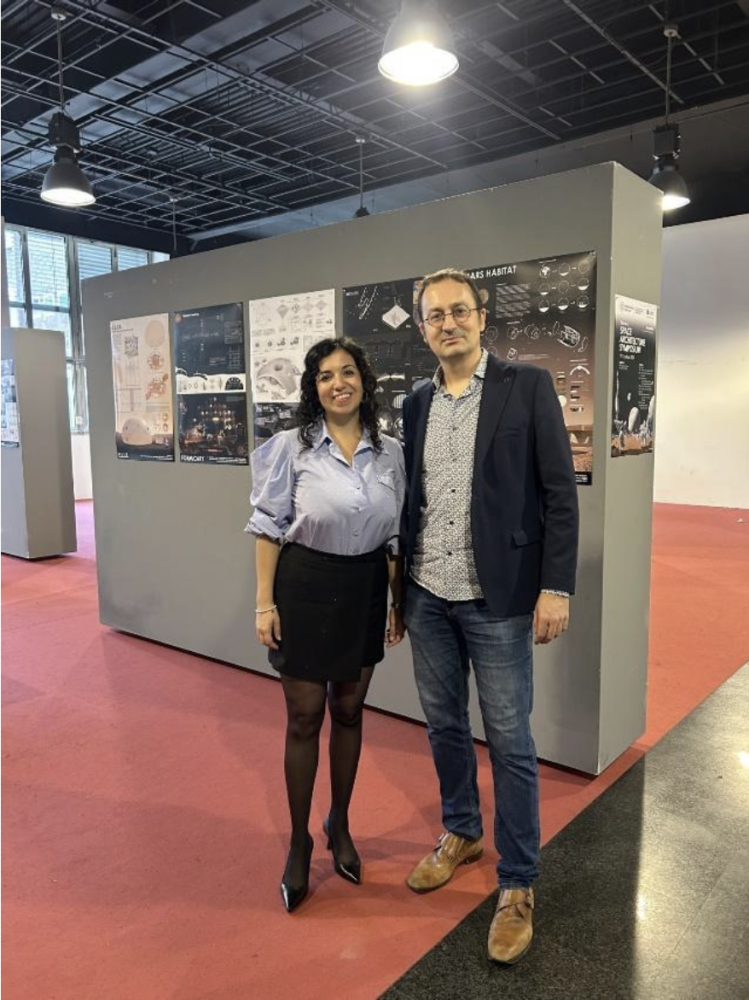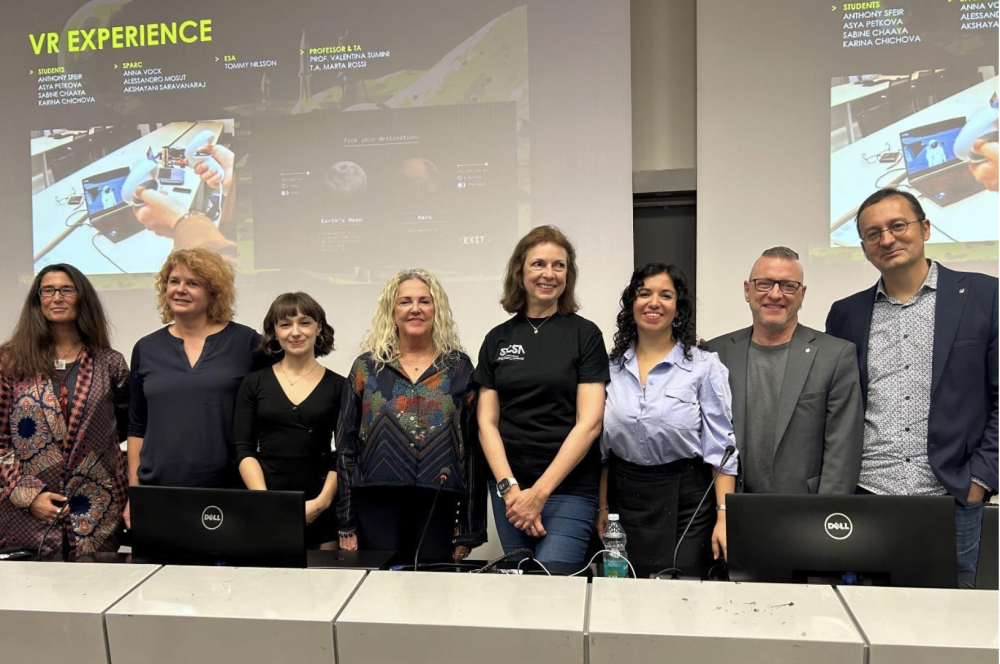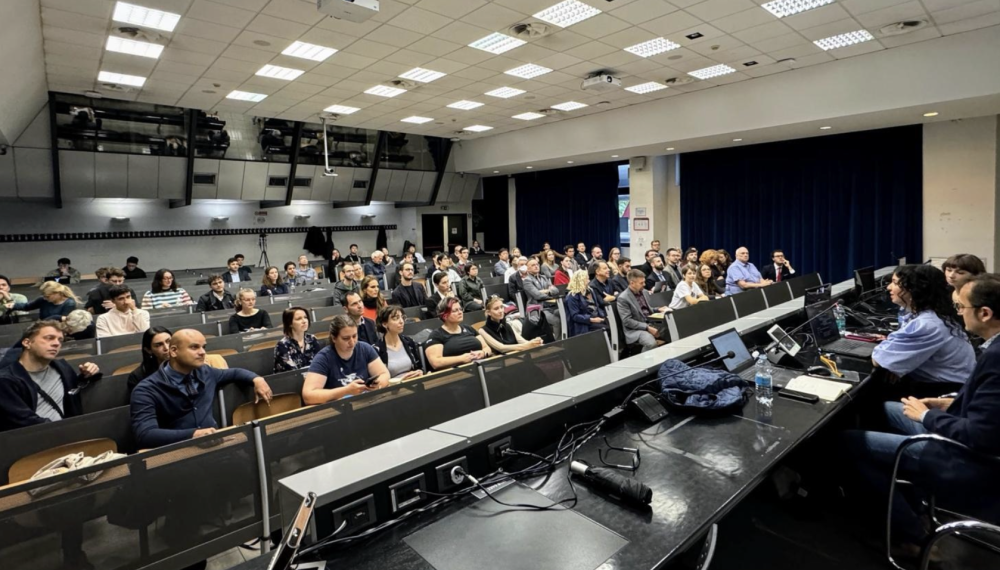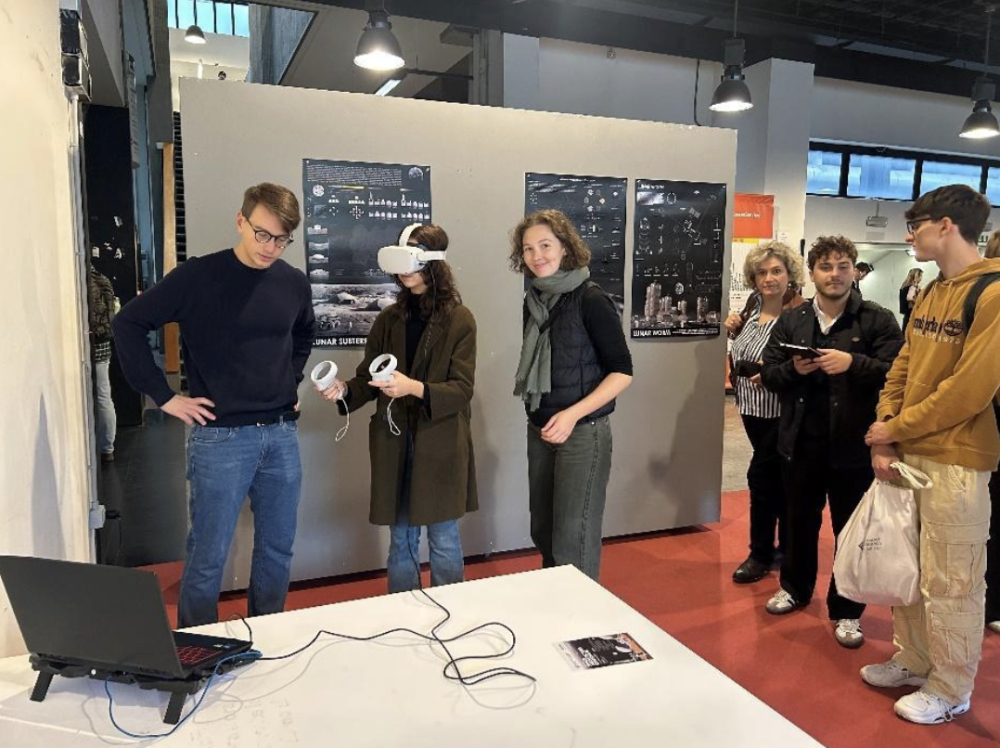The Space Architecture Symposium – Politecnico di
Milano – 2024
Date | 19th October 2024, 8am-9pm.
Venue | Aula Rogers. Politecnico di Milano – Facoltà di Architettura. Via Ampere, 2 Milano, Italy.

The SAS Milano session, organized by Valentina Sumini, Visiting Professor at Politecnico di Milano, and Georgi Petrov, was hosted at Politecnico di Milano thanks to the support of the Dean, Prof. Andrea Campioli, and in collaboration with the AIAA Space Architecture Technical Committee (SATC), Marta Rossi, and the students of Politecnico di Milano.
The event opened with Valentina Sumini and Georgi Petrov welcoming the international community of space architects. Georgi Petrov, Chair of the SATC, introduced the committee’s background, noting its affiliation with the AIAA and its global reach. He explained that the committee organizes sessions at major conferences such as AIAA SciTech, IAC, and ASCEND, and highlighted the website spacearchitect.org as a central repository containing over a thousand publications, lectures, and podcasts. His talk concluded by recalling the origins of the community, first formalized in Houston in 2002, and its steady growth, with more than 200 attendees now participating in the symposium.
After a brief introduction outlining the structure of the event, the program continued with a keynote by Brent Sherwood, former Senior Vice President for Advanced Development Programs at Blue Origin. Revisiting the original 2002 definition of space architecture, he emphasized its dual nature as both theory and practice — bridging engineering precision and architectural vision, and extending from vehicles to habitats. Examples such as the Apollo Lunar Module and Skylab illustrated the evolution from compact, machine-like environments to larger, livable spaces. The International Space Station, he noted, represents a comprehensive system that teaches architects to value resource cycles — air, water, power — as integral components of human life support. This systems-thinking approach, Sherwood argued, can also inform sustainable terrestrial design.
The session continued with a presentation by Franco Fenoglio of Thales Alenia Space, who provided an overview of the NASA Artemis program and Europe’s contributions to NASA’s renewed lunar exploration efforts. Launched in 2019, Artemis marks a shift from the Apollo era toward a sustainable, international approach to human presence on the Moon, with the first crewed landing — featuring the first woman on the lunar surface — planned for 2026. Fenoglio outlined the program’s five pillars: the Space Launch System (SLS), the Orion spacecraft with its European Service Module (ESM), the Gateway outpost, the Human Landing System (HLS), and the future Lunar Base Camp. Thales Alenia Space plays a central role in developing key elements of this infrastructure, including structural and thermal systems for the Orion ESM, the HALO and I-Hab modules for the Gateway, and the lunar view module, featuring a panoramic observation bay. He also discussed ongoing work on the Multipurpose Habitat (MPH), a mobile pressurized module for the lunar surface developed with the Italian Space Agency, and the Argonaut logistics lander, capable of delivering over two tons of payload to the Moon. Emphasizing a stepwise “Moon-to-Mars” strategy, Fenoglio described how the technologies and operations developed through Artemis will serve as precursors to future human missions to Mars.
Following this presentation, the discussion turned to one of the main factors behind the growing global interest in space architecture: the emergence of strong educational programs within schools of architecture. As Georgi Petrov noted, several pioneering academic initiatives have helped consolidate this field — including two programs currently offered at Politecnico di Milano by Valentina Sumini and Annalisa Dominoni. The panel brought together leading educators shaping the discipline internationally:
- Valentina Sumini, Visiting Professor at Politecnico di Milano (Dept. ABC) and Research Affiliate at the MIT Media Lab, MIT Space Exploration Initiative;
- Annalisa Dominoni, Architect and Design Professor at Politecnico di Milano;
- Olga Bannova, Director of the Sasakawa International Center for Space Architecture (SICSA);
- Sandra Häuplik-Meusburger from TU Wien, founder of a new executive program in Space Architecture;
- Elena Rocchi, Director of the new Master in Space Architecture and Extreme Environments at Arizona State University (ASU).

During the panel, Valentina Sumini presented her course Architecture for Human Space Exploration, offered within the School of Architecture, Urban Planning, and Construction Engineering at Politecnico di Milano. Developed in collaboration with MIT’s Senseable City Lab and the MIT Space Exploration Initiative, the course adopts a multidisciplinary and computational design approach, linking smart lunar and Martian settlements with intelligent urban systems on Earth. The pedagogical model promotes sustainability by design and leverages advanced computational tools, including AI-based algorithms and multi-objective optimization, to help students integrate mission parameters, environmental constraints, and structural efficiency in their space habitat concepts. The course promoted an XR-enabled computational design approach to support the interior design and ergonomics of space habitats, addressing habitability criteria and allowing students to evaluate the usability of the spaces they were designing within a virtual analogue environment. Through numerous projects developed in partnership with space agencies (ESA, NASA), industry (Thales Alenia Space), and academia (Politecnico di Milano, Alta Scuola Politecnica, Politecnico di Torino), the program demonstrates how architectural education can actively contribute to both space exploration and terrestrial innovation.
Annalisa Dominoni followed with a presentation on her course Space4Inspiration and the activities of ESA_LAB@PoliMi, which focuses on comfort, performance, and psychological well-being in microgravity. The lab collaborates with ESA and Thales Alenia Space, bridging education and industry. Her course, part of the Integrated Product Design program, employs concept design as a tool to envision sustainable living systems. Projects include lunar greenhouses with algae cultivation, inflatable habitats within lava tubes, and speculative space tourism scenarios. The approach fosters creativity and speculative design grounded in scientific feasibility.
Olga Bannova traced the 40-year history of SICSA and its evolution from conceptual studies to technically rigorous design education. Now part of the Department of Mechanical and Aerospace Engineering, the center trains architects and engineers to collaborate on practical lunar and orbital projects. Students work with Boeing, Axiom, and NASA on deployable structures, surface logistics, and mixed-reality testing. The emphasis is on evidence-based design, low-fidelity mockups, and VR integration to evaluate ergonomics and crew operations — with many graduates joining major aerospace companies.
Sandra Häuplik-Meusburger described TU Wien’s long-standing program in space design, active for more than 15 years. The curriculum now includes an Executive MBA in Space Architecture, open to professionals from architecture, engineering, and space sectors. The program fosters interdisciplinary collaboration and international partnerships — including Abu Dhabi University and HIT China — and emphasizes project-based learning and real-world applications.
Finally, Elena Rocchi introduced ASU’s new Master in Space Architecture and Extreme Environments, inspired by Guillermo Trotti and SICSA’s legacy. The program promotes accessibility and diversity, integrating students from a range of backgrounds. It connects space design with Earth sustainability, emphasizing that all space innovation should benefit life on Earth. The course combines VR-based experiential learning at ASU’s Dreamscape Lab with partnerships across five continents, preparing students for roles not only at NASA but also in emerging private and commercial space industries.
After the panel, Marta Rossi, PhD candidate at Politecnico di Torino and teaching assistant at Politecnico di Milano, introduced the Students’ Poster Session, featuring 43 posters developed by students from nine countries and sixteen universities, including Politecnico di Milano, Politecnico di Torino, TU Braunschweig, University of Innsbruck, TU Wien, University of Southern Denmark, Harbin Institute of Technology, Massachusetts Institute of Technology, University of Houston, ArtCenter College of Design, Arizona State University, University of Queensland, University of Technology Sydney, University of Western Australia, Abu Dhabi University, and TU Delft. She then presented a VR experience developed from a project in Prof. Sumini’s course Architecture for Human Space Exploration, later implemented as an immersive environment through collaboration with the SPARC project at Politecnico di Milano and ESA Postdoctoral Fellow Tommy Nilsson. The session concluded with an invitation for the audience to explore the posters, engage with the authors, and experience the VR installation.
The afternoon marked a pivotal moment in the event: in 2024, the SATC launched the Space Architecture Decadal Survey, a collective effort led by the AIAA community to define the priorities and directions for space architecture research and practice over the next decade. Adam Oswald, Executive Secretary of the Decadal Survey, introduced the initiative, explaining that over the summer the team conducted a broad questionnaire and open call for white papers, receiving roughly 300 responses and 40 submissions spanning academic papers to unconventional formats. Alongside this, stakeholder interviews and in-person workshops — including the Milan session — are being conducted to surface needs and areas of consensus. The aim at this stage is to consolidate the raw inputs and identify emerging patterns.
Preliminary results highlight strong interest in defining the field’s identity, core skills, and future destinations — particularly the Moon, Mars, and commercial LEO habitats. Participants also emphasized the need for developing standards, educational programs, and career pathways to sustain growth. In the afternoon, symposium attendees joined six thematic breakout sessions — Visitors, Workers, Explorers, Settlers, Education, and Employment — contributing directly to the Survey’s forthcoming report.
Representatives of the Decadal Survey chapters to briefly introduce their sections:
- Bill O’Hara, Lunar Habitat and Formulation Lead at Blue Origin, presented the Explorer chapter, focusing on short-duration missions involving small crews operating in hazardous environments, and the role of space architects in these constrained contexts.
- Gui Trotti, Professor of Practice at ASU, introduced the Workers section, examining astronauts, engineers, and technicians working in orbital stations or lunar bases, drawing parallels with Antarctic research stations.
- Brent Sherwood and Barbara Imhof, Managing Director of LIQUIFER Systems Group, presented the Visitors chapter, exploring the expectations and design challenges associated with space tourism and short-term guests. The Settlers section addressed the transition toward permanent habitation beyond Earth, emphasizing education, long-term infrastructure, and skills transfer.
- Melodie Yashar, Vice Chair of the SATC and incoming Chair (2026–27), together with Xavier De Kestelier, Head of Design Technology and Innovation at Hassell, led the Employment chapter, investigating professional pathways and the evolving landscape of space architecture careers.
- Paolo Caratelli, Associate Professor at Abu Dhabi University, and Olga Bannova introduced the Education chapter, focusing on the development of standards, publications, and shared methodologies to support the profession’s growth.
The symposium concluded with parallel working sessions dedicated to each Decadal Survey chapter. Special thanks go to those who helped co-lead the sessions: Amit Srivastava, Silvio De Mio, Xavier De Kestelier, Olga Bannova, Annalisa Dominoni, and Benedetto Quaquaro.
Participants joined two different groups, each led by a chapter coordinator, to share insights and recommendations. The sessions were recorded to collect contributions that will inform the final draft of the Decadal Survey report — a milestone toward defining the collective vision for the next decade of human space design.
Pictures from the event:









